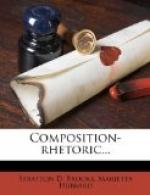In making a written report of conversation you should remember that short sentences predominate. A conversation composed of long sentences would seem stilted and made to order. What each person says, however short, is put into a separate division and indented. Explanatory matter accompanying the conversation is placed with the spoken part to which it most closely relates. Notice the indentations and the use of quotation marks in several printed reports of conversation.
+20. Ideas from Pictures.+—If you look at a picture and then attempt to tell some one else what you see, you will express ideas gained by experience. A picture may, however, cause a very different set of ideas to arise. Look at the picture on page 38. Can you imagine the circumstances that preceded the situation shown by the picture? Or again, can you not begin with that situation and imagine what would be done next? If you write out either of the series of events, the theme, though suggested by the picture, will be composed of ideas furnished by the imagination. In the writing of a story suggested by a picture, the situation given in the picture should be made the point of greatest interest, and should be accounted for by relating a series of events supposed to have preceded it.
+Theme IX.+—Write a story that will account for the condition shown in the picture on page 38.
(Correct with reference to clearness and meaning. Do you need to change the sentence length either for the sake of clearness or for the sake of variety? Cross out unnecessary ands. Underscore got and then each time you have used them. Can the reader follow the thread of your story to its chief point?)
[Illustration]
+21. Vocabulary.+—A word is the symbol of an idea, and the addition of a word to one’s vocabulary usually means that a new idea has been acquired. The more we see and hear and read, the greater our stock of ideas becomes. As our life experiences increase, so should our supply of words increase. We may have ideas without having the words with which to express them, and we may meet with words whose meanings we do not know. In either case there is chance for improvement. When you have a new idea, find out how best to express it, and when you meet with a new word, add it to your vocabulary.
It is necessary to distinguish between our reading vocabulary and our writing vocabulary. There are many words that belong only to the first. We know what they mean when we meet them in our reading, but we do not use them in our writing. Our speaking vocabulary also differs from that which we employ in writing. We use words and phrases on paper that seldom appear in our speech, and, on the other hand, many of the words that we speak do not appear in our writing. There is, however, a constant shifting of words from one to another of these three groups. When we meet an unknown word, it usually becomes a part of our reading vocabulary. Later it may appear in our written work, and finally we may use it in speaking. We add a word to our reading vocabulary when we determine its meaning, but we must use it in order to add it to our writing and speaking vocabulary. A conscious effort to aid in this acquisition of words is highly desirable.




